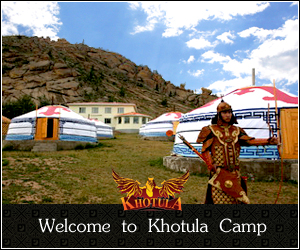Folk Tales
treasury of the language of the people, because, while folklore often
echoes literary influences and distant cultural factors, carried along
as stories travel for thousands of miles, from one nation to another,
In the oldest long document in the Mongol language, the famous "Secret History" we have preserved for us two kinds of language. There are passages in the language of the old tribal aristocracy of the twelfth century and the language of the rapidly developing new feudal nobility of the thirteenth century, and passages also in the direct, colourful language of the common people. By the end of the nineteenth century, there were great changes. Through the influence of the Buddhist religion, the written language had been deeply penetrated by Sanskrit and Tibetan elements, and through the influence of the Manchu-Chinese imperial bureaucracy by Confucian elements. If we compare this "late" written style with the spoken language preserved for us in folklore, we can see that on the one hand the foreign influences were corrupting the written language, making it more and more the stilted language of the privileged classes; on the other hand, when the very same elements entered the stories told to each other by the ordinary Mongols who could not read and write – the people who did the hard work of herding animals, hunting, preparing wool to make felt, tanning hides, leading heavily loaded caravans of camels or ox-carts over great distances, serving as soldiers, providing relay-transport for travelling nobles and officials – the stories were told in such a way that the foreign elements were "mongolised". This was because the common people had their own realistic way of understanding ideas, morals, ethics, and social concepts of all kinds.
It has long been assumed by people who call themselves "civilized" in China and in Western countries, that because most of the Mongols were illiterate, they were also ignorant, and because they were ignorant, they were also stupid. But being unable to read is not the same thing as being ignorant, and a man who is ignorant is not necessarily a stupid man. We can see from the folklore of the Mongols that the people who told these stories to each other in fact had a wide range of knowledge, especially knowledge of nature, knowledge of human nature, and knowledge, most important of all of the nature of society. Many of the folk tales show a sharply intelligent understanding and criticism of social structure and social injustice.
It is fortunate for those in every part of the world who want to understand what pre-industrial societies were like that a great mass of Mongolia's folklore has been preserved. It is especially fortunate for the Mongols themselves that, in the years of their socialist revolution since 1921 this folklore has been faithfully written down. It has done two things for them. It has preserved the vigour of the spoken language, and it has communicated this vigour, this characteristic of being "of the people", to the radiply developing literature. In all the best of the novels and short stories being written in Mongolia today one can trace the influence of the great folklore tradition – the speech of the common people, the way the world is understood by the men and women who do the work of the nation.
For those who read English, Mr. Altangerel has done, with loving care and accuracy, a work for which we must all thank him – a work which brings us and the Mongols closer together, in a common world in which mutual understanding is increasingly possible.












